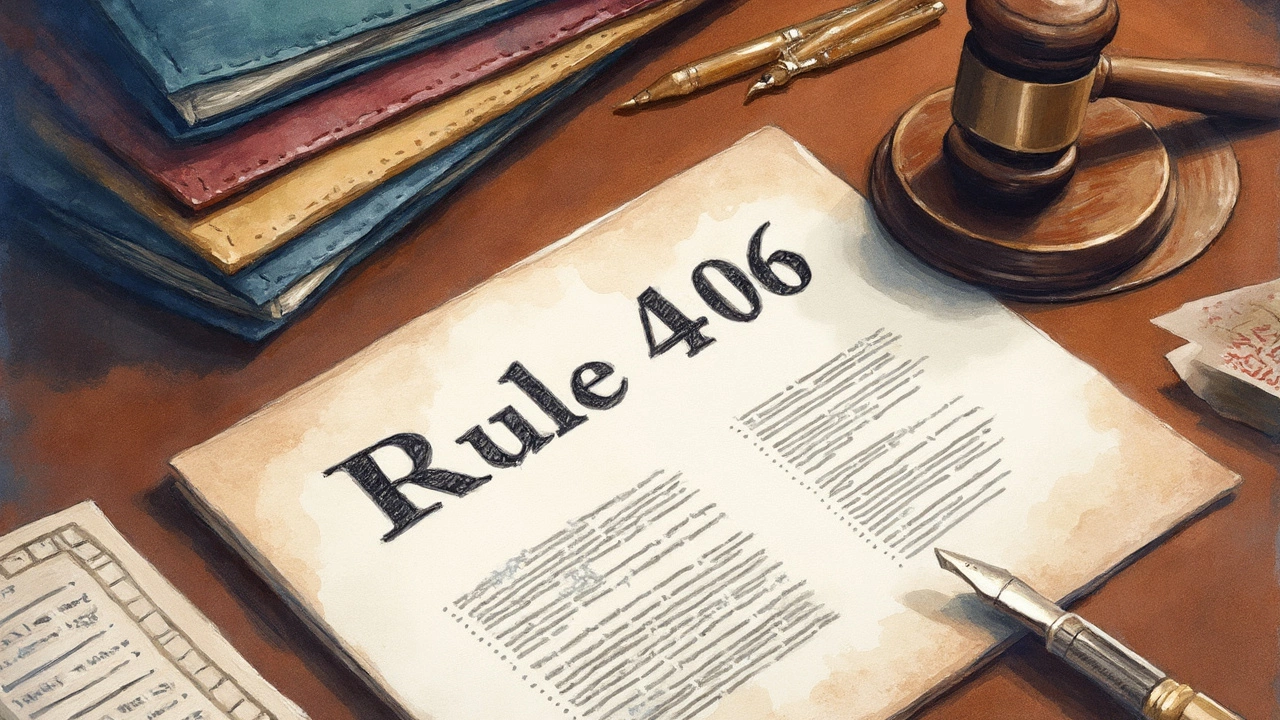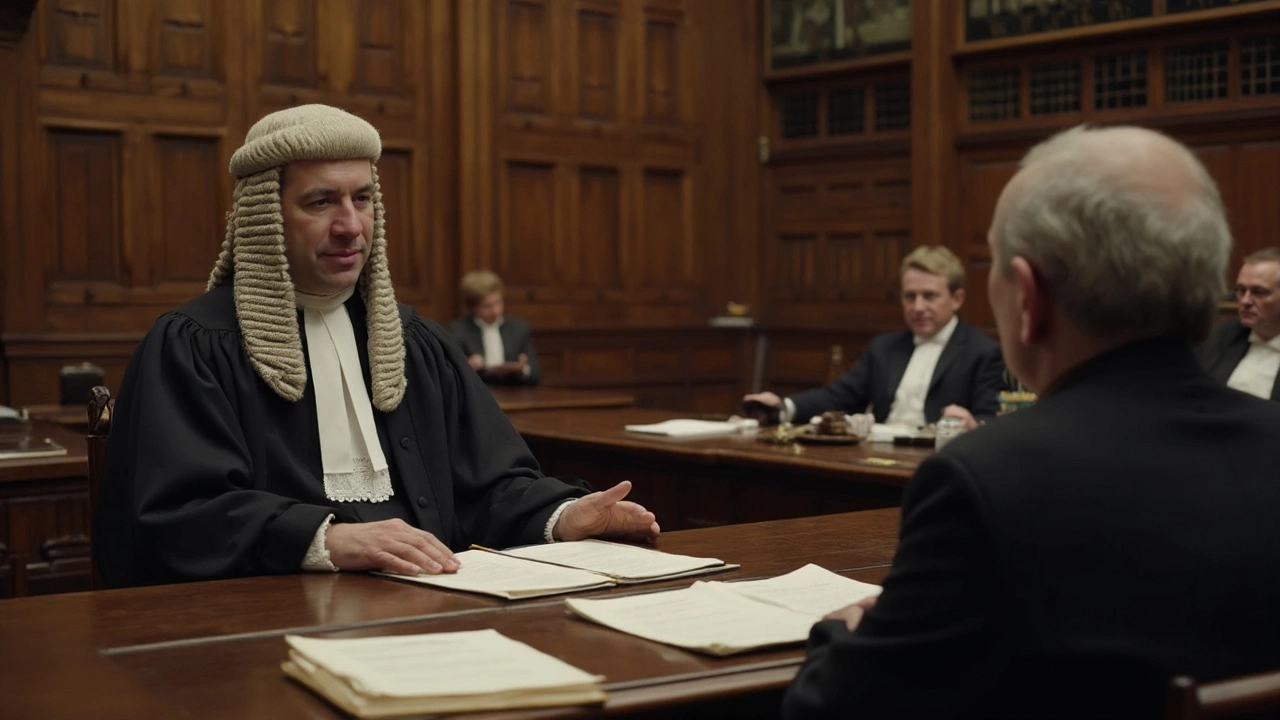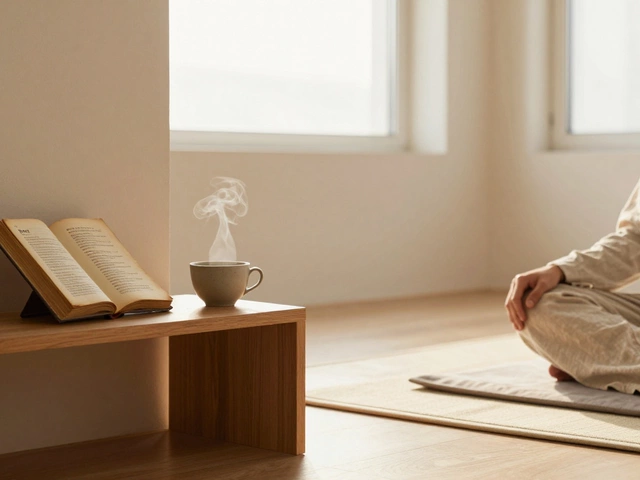Imagine someone showing up in court, trying to prove something with stories about what a person usually does, not just what happened once. Sounds odd? Not really. Rule 406 lets lawyers do exactly that—shine a spotlight on someone's habits to prove what probably happened in a specific case. There’s a reason Rule 406 is one of those sneaky-powerful rules in the legal world. People talk about evidence, confessions, and hearsay all the time, but ‘habit evidence’ quietly decides who wins and loses more cases than most folks realize. Let’s unravel what this rule actually covers, what makes it special, and some real-life scenarios where it’s made all the difference.
Understanding Rule 406: What It Really Means
If you’ve ever wondered how a lawyer can talk about what someone "always" does instead of focusing only on what happened the day of the event, Rule 406 is why. The rule comes from the Federal Rules of Evidence, which courts across the United States use as their evidence playbook. Here’s the core text: "Evidence of a person’s habit or an organization’s routine practice may be admitted to prove that on a particular occasion the person or organization acted in accordance with the habit or routine practice." That mouthful translates to something pretty simple: if you always take off your shoes at the front door, and there’s a question about whether you did it that day, your regular practice can be used to show what you likely did—without having to prove you were thinking about it, or even exactly remembering it.
Unlike character evidence, which is usually about what a person is generally like (honest, careful, reckless, etc.), habit evidence drills down into a specific, predictable behavior that’s almost automatic. Rule 406 draws a clear line: you can’t just say, 'Oh, he’s careful.' You need proof the person acts a certain way in the same kinds of situations again and again, like always buckling their seatbelt before starting the car or washing hands after handling chemicals at work. Courts want to see real regularity—something you’d bet money on happening most of the time, not just a couple of flukes.
Here's what makes Rule 406 even more interesting: it applies not just to people, but also to organizations and companies. Imagine a delivery company wants to prove its drivers always check their brakes before leaving the garage. If they have a specific routine, and it happens regularly, that pattern counts as habit evidence too. Per the law, this kind of habit evidence doesn’t even need extra witnesses saying they saw it happen every single time. The routine alone, proven as a fact, can convince a judge or jury that it most likely happened the day in question.
One classic example: a nurse testifies in a medical malpractice case. She always notes a patient’s vital signs in the chart every hour. The chart is missing an entry for one hour in particular. Thanks to Rule 406, her routine is strong evidence that she must have taken those vitals—even if she doesn’t specifically remember doing it that day. This becomes especially powerful in cases where records are lost, forgotten, or when no one was actually watching each step.
Let’s get clearer on what counts as a habit. A habit isn’t something you did a handful of times or started doing last week. Legally, it needs to look automatic, repeated, and consistent over time. As a rule of thumb, courts want to see the same action played out in the same situation hundreds, maybe thousands of times. Think of people who brush their teeth every morning right after breakfast. If it’s that reliable, it’s habit. If it’s more about occasional good intentions, like promising to start jogging each Monday, forget it—it doesn’t count.
The rule isn’t just for criminal trials. Civil suits, employment disputes, accident cases—Rule 406 pops up everywhere. Courts use it for everything from insurance claims (did the worker really lock the gate every night as required?) to slip-and-fall cases (does a store always put out warning signs after mopping the floor?). Habit evidence fills in the blanks when memories fade or paperwork goes missing, letting juries piece together what probably happened.
But still, there are limits. Judges won’t let lawyers dress up bad behavior as a ‘habit’ just to smear someone’s name. If someone’s arrested twice for the same thing, that’s not a habit in the eyes of the court. The rule demands a pattern so steady that it practically runs on autopilot—something you could film and show over and over, not just a couple of choices or quirks.
Curious about how often Rule 406 gets used? According to the National Center for State Courts, the rule comes up in roughly 8% of evidentiary hearings for civil cases and 6% for criminal trials each year. Here’s a breakdown:
| Case Type | Rule 406 Usage (%) |
|---|---|
| Civil Cases | 8 |
| Criminal Cases | 6 |
That may sound tiny, but those are just the reported statistics—so many more cases talk about habit without ever mentioning the rule by name. Every court wrestling with foggy memories or missing records looks at routine and habit, whether they say so out loud or not.

Why Rule 406 Can Make or Break a Case
Rule 406 flies under most people’s radar, but seasoned lawyers know its value. Let’s say someone claims you didn’t check the oven before leaving the house, and your house caught fire. If you’ve checked that oven every single day for years, your habit could convince a jury you did it that day, too. Suddenly, you have a powerful defense against carelessness claims, all thanks to your solid routine.
Habit evidence especially shines when cases depend on split-second decisions or when no one really remembers what happened. In workplace safety disputes, for example, showing a company’s strong habit of running equipment checks can save millions in liability. For health professionals, proving they always follow sanitation routines can protect them from malpractice suits. If you can show up with regular training records, checklists, or protocols, that’s habit gold in the courtroom.
But there’s an art to using Rule 406. Not every repetitive act makes the cut—judges get picky about what they’ll allow. Courts look for things like:
- Regularity: Has the act been done nearly every time in similar situations?
- Specificity: Is the routine clear and specific, not vague or general?
- Automaticity: Does it look like it happens by force of habit, not conscious choice?
Let’s flip the coin for a second. Rule 406 can also bite you if you’re the one always doing something unsafe or careless. A worker who routinely skips locker room safety checks, for instance, can have that used against them when an accident happens. The same rule that saves careful people can sink the careless.
It gets complicated fast. Consider the case of evidence law professors, who love tossing Rule 406 scenarios at students: Can you use a bartender’s habit of always locking the front door at midnight to prove she did it on the night of a burglary? Courts have said yes—if you can show the pattern is steady and documented. But say a delivery driver just claims he "usually" follows the speed limit. That’s probably too vague—judges want cold, hard routines, not wishy-washy recollections.
And if you’re on the receiving end of habit evidence, how do you punch holes in it? Lawyers do this by showing exceptions. Maybe you always check your email before leaving the office, except when your dog gets sick. If you can show the day in question was out of the ordinary, that weakens the habit evidence. Even one or two clear breaks from routine can take the wind out of the other side’s sails.
That’s why good lawyers don’t wing it with Rule 406—they build a trail. They gather sign-in sheets, time-stamped logs, witness statements, and anything else that turns routine into proof. The more details, the better. It’s like a trail of breadcrumbs: each crumb makes it harder for the other side to argue you were off course that day.
One tip for anyone reading: if your work or life could ever end up in court—teachers, health workers, engineers, you name it—track your routines and keep some kind of record. Those boring sign-out sheets and daily checklists might just save your skin one day. Having a witness who can testify, "She always does it this way," can be incredibly persuasive—but having three years of records? That’s even better.
Still, don’t get too comfortable. Judge and jury attitudes change. In some states, judges are more willing to allow habit evidence; in others, they’re strict and demand almost robotic regularity. The U.S. Supreme Court in Hudson v. New York (1965) made clear that vague, "I’m usually careful" statements just aren’t enough. They want proof that’s rock-solid.
Rule 406 also interacts with privacy. Some lawyers try to use tracking data, digital logs, or even smart device records to bolster their arguments. Employers have started using building access logs and digital routines as habit evidence. In modern cases, that means your smartphone could become a star witness.

Real-World Examples and Takeaway Tips for Rule 406
Thousands of cases have turned on what people did by habit. Take the real-life example of Sanchez v. U.S. Postal Service (2011), where a mail carrier’s regular practice of checking a porch for stray dogs was used to defend her against claims she acted carelessly when bitten. The court accepted her routine because she had years of consistent, documented behavior. Another case: In a well-known Illinois civil suit, a janitor proved he always mopped floors after every shift by showing years of logs and testimony, helping the property owner defend against a slip-and-fall claim.
But courts have shut down habit evidence that’s too wishy-washy. When a doctor in Florida claimed he "usually" reviewed test results every night, the court said that was too broad, lacking the specificity and consistency needed for Rule 406. Results? Evidence tossed out. It pays to keep routines as clear and documented as possible.
So, what can you do to make sure Rule 406 works for—or against—you?
- Document everything: Keep daily logs, checklists, or digital records, whether you’re a worker, manager, or even a parent tracking medication schedules.
- Train your team: The more systematic your work routines, the stronger your habit evidence if you ever need it—in court or for insurance claims.
- Review your weak spots: Identify habits that could get you in trouble, and change them before they leave a trail.
- Get witnesses: If possible, have co-workers or supervisors verify your regular routines.
- Be specific: In court, vague ‘I’m careful’ claims don’t fly. Detail what you do, when, and how often.
If you’re on the other side, look for proof of exceptions. Find the moments when routines broke, and bring those to light. Even one believable exception can poke holes in a habit claim.
For anyone running a business, setting up and enforcing standard operating procedures makes all the difference. Not only do routines make your life easier—they can keep your company out of hot water. Don’t dismiss the power of regular checklists and daily sign-offs—they’re habit evidence in the making. In the age of digital everything, even your electronic footprint (badge in/out records, digital logs) can help prove or disprove someone’s routine.
Here’s a quick checklist that sums up what counts—and what doesn’t—for Rule 406 purposes:
- It must be a repeated, almost automatic act.
- It must happen in exactly the same situation each time.
- One or two outliers don’t break a habit, but too many exceptions do.
- Records, witness testimony, and digital logs make the best proof.
- Vague statements or wishful thinking don’t count as habit evidence.
Don’t underestimate habit in the courtroom. Rule 406 isn’t just a footnote in the rules of evidence; it’s a powerful tool for proving the probable when memories fade, stories shift, or people just plain forget. Whether you’re building your case or protecting yourself from one, knowing what counts as habit—and keeping the proof—can be the difference between winning and losing when it matters most.







